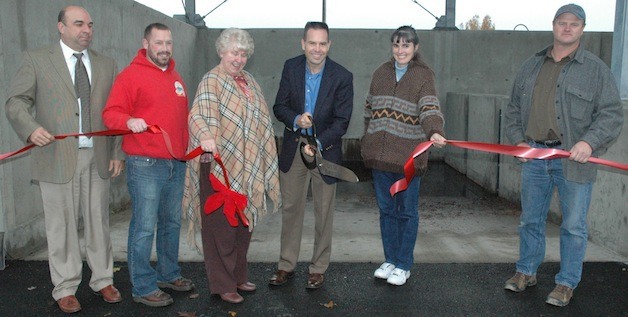MARYSVILLE — The city of Marysville and the state Department of Ecology celebrated the concrete evidence of their partnership with a ribbon-cutting on Wednesday, Nov. 6, marking the city’s new decant facility, adjacent to its Public Works Building.
According to Project Manager Jeff Laycock, the decant facility is the center of the city’s solid waste handling process for Public Works.
“The city currently takes in more than 1,000 cubic yards of solid waste each year through maintenance operations, including street-sweeping, and cleaning out catch-basins, stormwater ponds and ditches. This amount has increased over the years, due to permit requirements and expansion of the city through annexation and growth.”
Laycock explained that each load from a sweet-sweeper or vactor truck is emptied into the decant facility, where solid waste settles out from liquid waste, the latter of which is then discharged into the city’s sanitary sewer system for further treatment.
“This process eliminates pollution runoff and keeps our surface waters, such as nearby Ebey Slough, clean,” Laycock said. “The decant facility has provided the city with the means to process our own waste materials. In 2012, we were only the second city in Snohomish County to secure a Solid Waste Handling permit from the Snohomish Health District.”
That permit provides approval for the reuse, and guidance regarding the proper reuse, of the waste materials generated by the city’s decant facility.
“Over the last two years, we’ve achieved 100 percent reuse of all processed decant waste,” Laycock said. “This alleviates the need to pay for the landfilling or incineration of solid waste, and saves taxpayers thousands of dollars. The reuse material has been utilized for trench backfill, roadside embankments and in-fill areas throughout the city.”
Laycock asserted that the decant project has also contributed to the improvement of the city’s handling and storage of materials within its yard in general.
“We’ve re-oriented our storage areas so that handling processes are central to our yard,” Laycock said. “We’ve constructed a new covered dome, and will likely construct another covered dome in the near future.”
Marysville Mayor Jon Nehring expressed his appreciation to the DoE for their contribution, through the 2012 Statewide Stormwater Grant Program, of $862,500, or 75 percent of the total project cost of about $1.1 million.
“Without their financial and technical assistance in this project, it likely never would have been completed,” said Nehring, who extended his thanks to SRV Construction, the general contractor for the project, and design consultants Gray & Osborne.
“Together with their subcontractors, SRV completed the project within budget, and well below the number of working days allotted for the work,” said Nehring, who likewise credited Gray & Osborne with completing the project design “in a timely manner” and within budget, so that the project could be bid and constructed this year. “This enabled us to begin using the facility before street-sweeping operations ramped up this fall.”
Nehring also mentioned “the integral part” played by city of Marysville staff members and crews in both the design and construction of this project.
“I’m grateful for the opportunity to partner with the Department of Ecology on this successful decant facility project for the treatment and safe disposal of stormwater waste,” Nehring said. “Our citizens will be happy to know that it’s good for the environment, and reinforces our commitment to environmental stewardship, it will eliminate pollution runoff, and it will help keep our surface waters clean.”



